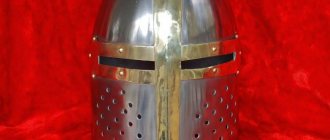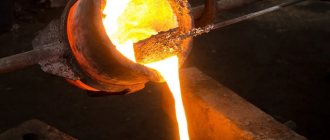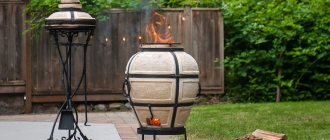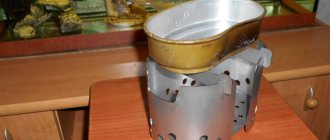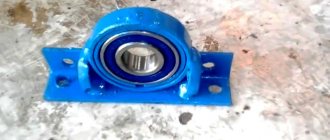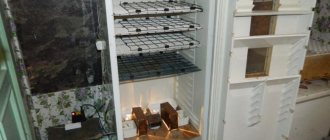Why do they even put doors on the fireplace?
It is believed that a glass door is a necessity for a modern fireplace.
Everyone sees something different in this. The advantages of a fireplace door seem to be undisputed. So why? Safety.
With a fireplace door, you don't have to be afraid to step away from the fireplace. After all, at any moment a coal can jump out and burn through the flooring. Children may get burned. Smoke may come out, after all... There is an opinion that in general “there are no fireplaces that don’t smoke”... and so on.
Energy efficiency.
A fireplace door prevents the biggest disadvantage of open fireplaces. They keep you warm while they burn. But as soon as active combustion ends. All the heat is “blown out” quite quickly into the pipe. A very large volume of air is “pumped” through an open fireplace, which does not allow it to be used as a full-fledged heating device.
With the installation of the door this problem goes away. At any time, you can cover/close the ash pit and the coals will burn out without sacrificing all the heat that the burning wood provided.
Aesthetics.
It is generally accepted that a fireplace door with glass prevents possible smoke in the fireplace. The fireplace spits less when there are pressure changes and problems with the flow of combustion air. Dark marks of soot do not appear on the arch/covering of the fireplace.
Large fireplace door, fresh from the workshop.
Glass door installation
Before installing a door with glass in the stove, you should check its ease of opening. If the part moves tightly, it should be developed. This will allow you to use the door as conveniently as possible in the future.
Usually in small heating appliances the temperature does not rise high enough. In addition, the frame is not exposed to open flame. For this reason, expansion of standard furnaces is minimal. Even when a piece of wire is exposed near the door, the wire itself holds in place very tightly.
There is an effective way to fasten the fire door, which prevents it from falling out. It is necessary to rivet special metal plates to it from the bottom and top. It is better to choose products with flared edges. Once all the steps are completed, the plates should be pressed into the brick.
Installation of the combustion door is carried out in stages:
- First, lay the grate.
- After this, plates and wire are attached to the door. As soon as the preparations are completed, the product is installed on the solution.
- Afterwards, the wire and plates are placed on the inner walls of the combustion chamber.
- The other ends of the metal elements are placed on 2 bricks, pressing on top with one brick.
The door angle is checked with a plumb line. Then the last wire is inserted into the door hole. It must be twisted tightly enough so that rings do not form. The wire is then placed in a hole in the first rib of the brick. Then it is pressed on top of the mortar with a brick.
Determining door dimensions
The first step in making a door is to determine its dimensions. This procedure is very important, since a product that is larger or smaller than the required size will interfere with the normal operation of the device. And installing a door that is not the right size will be problematic. As a result, the work will have to be done again.
- To determine the height and width of the door, you will need a small tape measure and a marker (or other device) for marks, as well as a piece of paper and a pen for writing. You need to visually make approximately three marks along the length and width of the fuel chamber and measure the distances. If the length results from the lower left corner to the upper left differ from the same measurements in the right corner, it is necessary to record the smallest dimensions with an error of no more than one millimeter.
- If you want an arched oven door with your own hands, you need to measure the width and two heights: maximum and minimum. After this, determine the nature of the bend of your arch. For both rectangular and arched door types, you should first make a sketch on a sheet of paper, preferably in exact size. This will make it easier for you to transfer the desired shape and measurements to the material from which the door will be made.
The initial stage of creating a door will be establishing the dimensions. This procedure is extremely important, since a product that has inappropriate parameters will interfere with the proper functioning of the device. As a result, installing a door that does not fit will become problematic. Algorithm of actions:
- To determine the dimensions of the stove doors, you will need a tape measure and a marker for notes, paper and a pen. You need to visually make approximately 3 marks along the length and width of the chamber and measure the distance. When the length results differ at the corners, it is necessary to record the smallest parameters with a deviation of no more than 1 mm.
- When the user wants to make a door for an arched stove on his own, he needs to measure the width and 2 heights: the largest and the smallest. Then the bend of the arch is determined. For rectangular and arched types, you should draw a sketch on paper in advance, optimally in the exact size. This will make it easier to transfer the required shape and measurements onto the door material.
We suggest you familiarize yourself with How to make formwork for a foundation with your own hands
Stages of work
The first thing to do is cut out the corner. And then give the desired shape to the structure. In order to carry out this operation, you need to lay the corner on a flat surface, check the correctness of all connections, and then weld all the necessary parts. After finishing the work, you need to inspect the door again for correctness and compliance with the form.
Then you need to mark the inner contour of the frame on a sheet of metal. After finishing the markings and receiving all the measurements, you need to increase them slightly and leave a small allowance on each side. Taking these marks into account, it is necessary to cut out the part using a metal grinder. Since the door is planned with glass, it is necessary to have a piece of heat-resistant material that will be mounted.
Using the same tool, glass is cut to the required dimensions. Next, you need to weld the curtains to the frame. After this, you need to grab them to the common door frame. When this operation is completed, you need to make sure that nothing interferes with the opening and closing of the door. If this condition is met, then final welding can begin. The door handle is attached last.
DIY Methods
When a user plans to make a device on his own, he will need certain knowledge of furnace equipment, its structure and principle of operation. Of course, it will not always be possible to make a high-quality glass product, but it is permissible to try the metal option. Preparations:
- First of all, you need to choose the material for making the product.
- Next, the type and size of the future product are determined. The user's financial budget must be taken into account.
If you don’t have any imagination about the shape and model of the door, you can go online and look for a ready-made solution there. As a result, the user will be able to receive an exclusive product.
Important! To have confidence in the advisability of creating a device yourself, you need to familiarize yourself with all the advantages
Installing a manufactured door in a fireplace or stove with a brick body
- if the door is glass, then the glass is first removed from the frame;
- then the door is applied to the edge of the fireplace in such a way as to cover the entire surface of the firebox;
- a cutting line is drawn on the surface of the brickwork;
- grooves are cut out in the masonry using a grinder;
- a second cut is made from inside the furnace so that part of the masonry can be removed;
- unevenness of the chip is leveled with a chisel;
- the door is fitted into the slot;
- the door is removed and the fastening tape is screwed to it;
- a small volume of oven mixture is mixed (for half an hour of work);
- an asbestos cord is dipped into the stove mixture solution, which is then wrapped around the perimeter of the firebox;
- the combustion door is wrapped with a cord several turns;
- the door is installed back into the hole and secured with dowels;
- noticeable seams must be filled.
The structure is ready.
When installing fireplace doors without brickwork, you will need to drill 4 holes with a diameter of 4 mm. To do this, the attachment points are marked with a marker. The remaining stages of work are similar to those described above.
Oven
The oven is usually made of strong steel. The gaps are determined using a level; the frame is wrapped in sheet asbestos, half a brick wide. The plane of the frame at the top must coincide with the masonry surface of the last row of bricks, therefore, if necessary, the asbestos layer must be increased.
The grate must be installed 25-30 cm below the combustion opening with a slope towards the combustion door. The bottom of the firebox is shaped like a trough, and the slots located between the grates should be along the firebox.
To prevent the grate from destroying the masonry when heated, it is necessary to leave 5 mm gaps, which are then covered with sand. The grate cannot be secured using the solution!
The blower door and, together with it, the cleaning door are installed in the same way as the firebox door. The blower door is practically not exposed to high temperatures, so it must be tightly and firmly walled into the stove masonry, treating the seams with clay mortar. The horizontal of the frame is also determined using a level.
Do-it-yourself fireplace door with glass - manufacturing procedure
You will need for work:
- Silicone sealant.
- 4 window panes to fit the screen.
- Stones for decoration.
- Metal mesh or grate.
- A metal box the size of which matches the base of the screen.
The algorithm for making glass for a fireplace with your own hands is as follows:
- Apply silicone sealant to all 4 panes around the edges.
- Fix the glass at right angles to create a parallelepiped-shaped structure.
- Press the planes firmly against each other and wait until they harden completely.
- Cut off any remaining silicone using a knife or razor blade.
- The screen is ready, now all that remains is to complete the base. Apply sealant to the bottom of the glass box and press the glass to the metal box. The sides of the metal box must be wide enough to accommodate the metal mesh grille.
- Now let's set up the firebox. Place a can of helium fuel in the middle of the box. Place a metal mesh on the sides (it can be laid in separate pieces). Place stones on top of the mesh, remembering to leave gaps between them for ventilation.
The original fireplace of the simplest design is ready!
What you need to prepare
The tools we will need are:
- electric drill or hammer drill;
- angle grinder;
- a hammer weighing up to a kilogram;
- welding machine and electrodes;
- roulette.
The following materials are needed:
- steel corner of the width that suits you;
- metal strip;
- hinges (turned eccentric);
- bolt;
- handle for opening.
You will determine the exact dimensions yourself and adjust the above drawing to fit them.
Material requirements
For fireplace doors, high-strength and heat-resistant thermal glass is used, which has undergone special hardening and processing. It can withstand up to 10,000 C for several thousand hours of direct use.
This glass contains elements such as heat-resistant quartz and transparent crystal ceramics. Quartz glass is the most popular because it has the smallest expansion when heated. This material is not inferior in strength even to metal products. Using ordinary thermal glass (for the sake of economy) is not advisable, since it cannot withstand temperatures exceeding 1500 C and may crack upon first use.
Glass can be of various sizes depending on the parameters of the fireplace, various geometric shapes and curvature.
It is possible to use tinted glass, which will muffle the bright light of the flame. Installed double or laminated glass will contribute to even safer use.
When choosing glass you need to consider:
heat resistance, paying attention to the type of fuel; service life, thickness of the glass screen (at least 3.5 - 4 mm).
Fireproof glass has a disadvantage: it is quite heavy.
. This must be taken into account when choosing door mountings and methods of their operation, creating the most comfortable conditions for handling this device.
Technical properties of heat-resistant glass
When choosing doors with glass for a fireplace, you need to not only look at their appearance, but also take into account certain technical qualities:
- Heat resistance. In the passport attached to each product, the manufacturer must indicate the recommended operating temperature, usually it is 500-550 degrees. The maximum value - about 1000 degrees - is found in laminated glass. In this case, you need to focus on the fuel used, for example, when heating with wood, the product should be more heat-resistant.
- The service life of fire-resistant glass is indicated by its manufacturers in hours. The higher the operating temperature, the longer the glass fireplace door can last. As a rule, manufacturers recommend not exceeding a combustion temperature of 550 degrees, provided that normal draft force is ensured.
- Glass screen thickness. This indicator affects the strength of the door, so it should be 3.5–4 millimeters.
- Single-layer glass is better than multi-layer glass, but for a home unit it will be sufficient.
- Self-cleaning function available. On the inside, a thin layer of metal oxide is applied to the fireproof material of the door. The invisible coating increases the surface temperature, causing the soot to burn completely.
- Noise insulation. This property can protect a person from the sounds of burning fuel.
Groups of doors in the process of laying
Fire door
The stove design includes doors for various purposes. Each element has its own role. The following doors are separated:
- furnace;
- view;
- blowers;
- cleaning
Furnace
Designed for storing fuel. The combustion door performs the following functions:
- protection of the surrounding area from fire;
- heat transfer from material burning in the firebox to the room;
- preventing sparks from flying out;
- provides combustion with oxygen.
Podduvalnaya
It is installed on the ash chamber, through which the oven is cleaned of ash that spills into the lower compartment. The blower door provides the process with air. By opening or closing it, the flow and rate of fuel combustion are regulated.
Blower doors are made of cast iron or steel, less often glass. They can be of a simple design, or they can be made of cast iron with a relief finish or ornament. They are made in the same style as fireboxes.
Cleaning
They close the hole in the chimney wall and serve to clean it from soot and soot. This is a necessary element in the design of the stove, ensuring its proper operation. Some builders ignore their installation, but an experienced stove builder will never do without cleanout holes. Their presence simplifies stove maintenance and smoke-free operation.
View
To prevent hot air from leaving the stove after combustion of fuel, a damper is installed on the chimney. It is a frame with grooves along which a plate moves, blocking the smoke exhaust channel. The valve is placed in the brickwork of the pipe.
Cleaning Blower Viewing
Characteristics
The designs of all stoves, unlike most fireplaces, require the mandatory closing of the hearth. The furnace door for the stove has several functions:
- protects the room from open fire;
- ensures heat transfer from burning fuel to rooms;
- prevents sparks from entering the room;
- increases the efficiency of the combustion process;
- decorates the structure as a whole.
All elements of furnaces must be fire-resistant, mechanically strong, and prevent the occurrence of fires.
Conventional doors for the combustion chamber allow air to pass through because they are not sealed tightly with a regular handle. Compacted types have a clamping mechanism, which reduces the amount of air entering the interior.
On a note! There are completely sealed modifications with a sealing fire-resistant cord around the perimeter; in such designs it is possible to regulate the intensity of the incoming air flow.
An eye-pleasing feature of some doors is a glass insert mounted in the center; it does not perform any important functions, but it makes it possible to enjoy the sight of a burning fireplace, which many owners really like.
Installing a manufactured door in a fireplace or stove with a brick body
The placement of the stove depends entirely on what exactly the owners expect from it. If it is installed in a small house and will be used as a fireplace for friendly gatherings, you can use the first scheme. This stove is a good option for cooking barbecue on the grill or kebabs.
Brick kiln placement options
The second scheme is for a house of solid square footage. In this case, the front side of the fireplace stove opens into the living room, the stove walls heat both bedrooms, and the heat in the remaining rooms is maintained using heat exchange.
The third scheme with a stove for heating and cooking is a budget housing option for a bachelor or a small family. Pros: a warm bed and the ability to place a dryer in the hallway.
Important: you should take care of the external insulation of the house in advance, because it greatly increases the efficiency of stove heating
- if the door is glass, then the glass is first removed from the frame;
- then the door is applied to the edge of the fireplace in such a way as to cover the entire surface of the firebox;
- a cutting line is drawn on the surface of the brickwork;
- grooves are cut out in the masonry using a grinder;
- a second cut is made from inside the furnace so that part of the masonry can be removed;
- unevenness of the chip is leveled with a chisel;
- the door is fitted into the slot;
- the door is removed and the fastening tape is screwed to it;
- a small volume of oven mixture is mixed (for half an hour of work);
- an asbestos cord is dipped into the stove mixture solution, which is then wrapped around the perimeter of the firebox;
- the combustion door is wrapped with a cord several turns;
- the door is installed back into the hole and secured with dowels;
- noticeable seams must be filled.
The structure is ready.
When installing fireplace doors without brickwork, you will need to drill 4 holes with a diameter of 4 mm. To do this, the attachment points are marked with a marker. The remaining stages of work are similar to those described above.
Preparation, list of tools
Before starting work, you need to determine and mark the place that the new stove will occupy.
The chimney pipe should be no closer than 15 cm from the roof rafters.
If you are doing masonry for the first time, professional stove makers advise you to practice in advance by making a model of the future stove from prepared bricks. Naturally, without a solution. This minimizes possible risks during real masonry, allowing you to learn from your mistakes, which can still be corrected in the layout.
The stove foundation requires preliminary waterproofing; its area must exceed the area of the stove.
When laying a new row, you need to control the absolute verticality of the walls.
To build a brick kiln, the following tools are needed:
- plumb line;
- trowel;
- roulette;
- putty knife;
- Bulgarian;
- knitting wire;
- building level;
- metal strips, corners;
- containers for cement and clay mortar.
Classification of furnace units
Most often, homemade stoves are made with cooking surfaces.
According to the characteristics of the device they are made:
- chamber;
- duct;
- bell-shaped
In chamber stoves, flue gases enter a special chamber and are completely burned there due to natural circulation. Their design creates a similarity to the burning of an ordinary fire in a confined space. In domestic models, the combustion compartment is connected to the afterburning compartment into a single module called the crucible. Its vaulted shape ensures complete combustion of fuel. An example of such a design is the classic Russian stove.
In a ducted unit, the flue gases first burn out, then gradually cool down and move through the channels located between the partitions. When moving, they give off heat to the furnace body. There is no afterburning inside until the temperature in the combustion chamber reaches 400 degrees. The efficiency of these devices does not exceed 60%.
In a bell-type furnace, combustion products move to the roof of a special bell and linger there, burning out completely. Then the gases sink to the bottom and give off heat to the body. To kindle such a unit, it is enough to warm up only a small area of the hood. Its efficiency can be 75%.
Pros and cons of ready-made stove ideas
Let's look at several reasons why people often choose the old type of heating for their home:
The first undoubted advantage is maintaining heat with a brick oven. Judge for yourself - such a stove keeps heat for at least a day, provided that you need to add firewood once every six hours.
The ability to store heat makes a brick stove very economical, because it does not require a constant source of fuel, moreover, they are much more environmentally friendly than their metal “brothers”.
The surface of such a stove does not heat up to such a high temperature that could leave a burn on the human body; on the contrary, if you lean your hand against it, you can feel pleasant warmth and comfort.
In addition to all of the above, a brick stove has aesthetics; look at the photo of a homemade stove and you will understand everything for yourself.
The downside, perhaps, is that a cold room takes a long time to heat up, but you can heat it up a little earlier or purchase special heaters that will warm the room at least a little while the main power warms up.
Preparation, list of tools
Before starting work, you need to determine and mark the place that the new stove will occupy.
The chimney pipe should be no closer than 15 cm from the roof rafters.
If you are doing masonry for the first time, professional stove makers advise you to practice in advance by making a model of the future stove from prepared bricks. Naturally, without a solution. This minimizes possible risks during real masonry, allowing you to learn from your mistakes, which can still be corrected in the layout.
The stove foundation requires preliminary waterproofing; its area must exceed the area of the stove.
When laying a new row, you need to control the absolute verticality of the walls.
To build a brick kiln, the following tools are needed:
- plumb line;
- trowel;
- roulette;
- putty knife;
- Bulgarian;
- knitting wire;
- building level;
- metal strips, corners;
- containers for cement and clay mortar.
Pros and cons of metal stoves
Metal is a durable material, but it is both ductile and malleable, which allows it to be given almost any design. It is able to withstand high loads and temperature changes. There are many methods for processing metals, so various technologies can be used in the manufacture of furnaces.
Another important advantage of a metal stove for a home is the integrity of the structure, so it can be moved and transported without any problems. This is impossible to do with large brick structures.
Due to their low weight, metal units do not require a separate solid foundation, and installation only involves the construction of a chimney. During the non-heating season, the mobile iron product can be moved to a utility room or shed and thereby free up space in the room.
The metal used as the material for manufacturing the unit has high thermal conductivity, as a result of which it heats up quickly, but also cools down similarly. Such heating helps to increase efficiency. In brick stoves, you must first wait until the internal heat exchange begins, and before that, during the heating process, all the resulting heat goes into the chimney.
Almost all the advantages of metal units are based on the characteristics of this material - it is quite dense, non-porous, and does not become damp under the influence of condensation like bricks. They are not at risk of long breaks in work; they do not need booster firing after downtime.
Metal stoves for summer cottages are easier to certify and it is easier to obtain a permit for them from the fire inspectorate, which will save both money and time. There are models on sale that do not require approval at all, but only the installation of an autonomous chimney.
But metal units also have disadvantages:
- They do not “breathe”, since, unlike brick, metal is not a porous material. When a brick oven cools, it absorbs moisture from the air and releases it when heated. As a result, a constant balance of humidity is created in the room, providing a feeling of comfort. Sometimes metal units are faced with brick to achieve a similar effect, but it is not as effective, and the structure loses its lightness and mobility.
- As already mentioned, metal quickly heats up and cools down, so in order to maintain heat in the house, the stove made from it has to be fired constantly, otherwise it will completely cool down in a few hours. This problem can be solved by manufacturing a metal unit that burns for a long time. But in any case, it is a permanent source that creates the risk of fire and fumes, and for this reason it cannot be left unattended for a long time.
- The main disadvantage of metal stoves is their fire hazard. When heated, their walls become heated to such an extent that they can cause ignition of objects, finishing materials, and floor coverings located in close proximity to the fire. Therefore, it is not easy to obtain permission from the Ministry of Emergency Situations to use an iron unit in a residential building - a separate boiler room will have to be equipped for it.
- The service life of a metal stove for home is up to 20 years. With frequent use, even thick metal burns out, as a result of which the walls of the product become thinner. But in just a decade of operation, the stove fully pays for its cost due to reduced fuel costs and the ability to replace the unit without repairs or redevelopment of premises.
Heat-resistant glass
So, we have found that in most cases, consumers prefer to install doors for fireplaces and stoves made of heat-resistant glass (the exception is those appliances that consume coal or mixed fuel). What is the secret of popularity? First of all, the fact that today the production of such glasses has noticeably improved and become more complex. The production process consists of several stages, such as:
- heat treatment;
- treatment with chemicals;
- polishing at high temperature.
Using special glass melting furnaces, manufacturers obtain sheets of material of the required thickness, and their surfaces are treated with special preparations that increase not only fire resistance and strength, but also the service life of the finished products.
After completing all technological stages, the finished fireplace glass acquires a lot of unique positive qualities, including:
- resistance to high temperatures;
- low warm-up rate;
- aesthetic and, so to speak, noble appearance;
- excellent noise absorption;
- ability to withstand significant temperature changes due to low thermal expansion;
- In addition, no visible defects, not even the smallest cracks, appear on the surface of the glass.
Moreover, today, unlike several years ago, heat-resistant glass is produced with crystal and corrugated surfaces, as well as tinted ones (in the latter case, the bright flashes of fire are somewhat muffled).
We have already mentioned above about glasses that can independently remove soot that appears on the surface. Such glasses are called self-cleaning and are distinguished by the fact that they are coated with an almost invisible ball of metal oxide. Due to this, the inner surface of the glass heats up to a higher temperature when fuel burns, and the soot, as a result, burns out almost completely.
How to care for fireplace doors?
We have already noted that metal doors for stoves and fireplaces do not require special care - you just need to paint them with heat-resistant paint. With glass models everything is somewhat more complicated. For example, even self-cleaning models must be periodically cleaned of accumulated soot. This procedure requires a damp cloth and detergent (the same “Mr. Muscle”), but without abrasive components and chlorine. This way you will not damage the glass and the protective layer.
What affects the frequency of cleaning? First of all, this is the type of firewood used (how much resin it contains) and the pulling strength.
This is interesting: Fittings for sliding interior doors
Features of metal stoves
The performance characteristics of heating units depend on the metal. Since its thermal conductivity compared to its heat capacity is much higher, this material does not accumulate heat well. The metal quickly absorbs thermal energy, heats up and soon cools down. If you take this property into account, you can assemble a metal fireplace with your own hands in such a way as to achieve high values with a minimum degree of heating.
Homemade metal stoves function differently depending on the design features:
- Chamber. These devices are actually an ordinary “potbelly stove”, the first examples of which appeared a couple of centuries ago, but they required a large amount of fuel. Then their design was improved - they placed a grate with a blower in it, shortened the chimney to 2.5-3 meters and insulated it. The peculiarity of the unit is that it is self-regulating - when the fire is fully fired, the throughput of the chimney pipe is not enough to remove the flue gases, as a result, turbulence occurs in the crucible, completely burning out the combustion products. Only then are the gases able to pass through the pipe. Since their temperature at the chimney outlet is about 100 degrees, there is no condensation. It is cleaned of soot once a year. The efficiency of such furnaces reaches 60%.
- Duct. Instead of a complex labyrinth of gas tubes, they have one elbow. It separates the combustion and afterburning chambers. Through an opening in the burner on the hob or an adjustable air throttle, secondary air is supplied to ensure afterburning of the flue gases. Since this process is carried out in one place, the efficiency is 70-80%. The performance of the stove is high, and the operating efficiency does not depend on the draft force or the size of the chimney. Since the main heat is generated in the afterburning compartment, the unit is used in two modes - flame and continuous combustion. They use different solid fuels, and the power is regulated not by the amount of wood or coal burned, but by tightening the throttle. Chimney cleaning is carried out every few years, provided that the stove is used properly. It is advisable to make the afterburner for it from heat-resistant steel, and in the shape of a trough. The body is made of ordinary steel, having a thickness of at least 4 millimeters, and the cooking surface is made of cast iron or thick 8 - 10 mm steel. It is advisable to make the stove removable, since over time it will need to be replaced as it will burn out.
- Bell bells. Long-burning stoves operate in smoldering mode, which makes it possible to make the heat transfer period longer. It can range from several days when using firewood and from 10 to 30 days for coal. If you use a simplified diagram of such a furnace, the fuel in it will smolder directly at the surface where oxygen enters. During the pyrolysis process, the fuel is split into volatile components, which, rising upward, burn in the bell, providing 60% of the heat. In order to increase this indicator, you can place a gas jacket on the stove, where the gases will burn out. As practice shows, as a result, the efficiency of such a stove can reach 80%, and sometimes more. If the choice is made in favor of this unit design, you need to remember some nuances. Despite the fact that such an iron stove for the home can operate on different solid fuels, the greatest effect from its operation is achieved when it is fired in the type for which it was originally intended. In this case, the fuel used must be dry, and it is not recommended to reload it until the previous load is completely burned. A large amount of toxic condensate always forms in the chimney of long-burning stoves, so it is necessary to create conditions for its safe drainage. To make the body of the unit, you can use a large gas cylinder or a used iron barrel.
- Oil-pyrolysis. These are known as waste stoves. This economical option is very popular among self-taught stove makers. The operating principle of the unit is simple. They pour waste into the tank, then set it on fire and supply oxygen through an air throttle; as a result, the combustion will not be strong, but it will be enough to evaporate the oil fuel. Vapors from the mining flow upward into a compartment in the form of a pipe with perforated walls through which air penetrates. During the combustion process, vapors are sent to an afterburner with a partition that traps nitrogen oxides in a certain temperature zone until they disintegrate and begin to release thermal energy.
Common mistakes
There are many nuances and difficulties in installing a stove.
This process is not as simple as it might seem at first glance. Everything must be done correctly so that there are no accidents during operation. In the bathhouse, the stove is heated very hot, and there are wooden elements and a high temperature, so for safety you need to observe the insulation as correctly as possible. All connections and installation must be done correctly and efficiently. This work is difficult, responsible and dangerous. Therefore, it is not easy to cope with such a matter alone.
When purchasing a stove in a store, they always offer installation, but some people want to do everything themselves, so they make many mistakes.
With a small area, some build baths close to other buildings, which makes a big mistake. To protect against accidents, the pipe at the bathhouse should be higher than all other buildings, and a grate should be installed on top to extinguish sparks.
Remember, repairs must be carried out in accordance with all safety regulations.
Recommendations for selection
A potential buyer, when choosing doors for stoves, is primarily concerned with their appearance, which is not entirely correct.
The successful shape and beauty of the material is not the only important factor; many other circumstances should be taken into account.
First of all, together with the stove maker you need to accurately calculate the required dimensions of the door, because there are many options in the range, and you need to buy exactly the required product.
The gap between the doors and the brickwork should be small; It cannot be completely excluded, because the material will expand as the temperature rises. During installation, the gaps between the brick and the doors are sealed with sealants made of basalt and mineral wool. As a last resort, asbestos is used, but given the harmful effects of fibers on the human respiratory tract, it is better not to use this material for residential premises.
You should decide in advance on the type of fuel you will use.
The amount of thermal energy released during combustion varies significantly, which should be taken into account
If family members really want to watch the flames, they will have to buy glass doors, being prepared to pay a significant amount for a pleasant purchase.
If there is an abundance of coal fuel in your place of residence, you don’t have much choice. Good coal supplies a large amount of heat when burning, so you need to buy cast iron products.
The most advanced products, which are expensive, have built-in sensors that show the temperature on the surface and the tightness of the internal space of the firebox.
Sources
- https://zen.yandex.ru/media/domspechkoy/samaia-luchshaia-kaminnaia-dverka-so-steklom-podrobno-5c987244d86ddb00b3fa7da4
- https://SdelatBanyu.ru/pechi-i-dymokhody/dvertsy.html
- https://www.tproekt.com/dvertsa-pechi/
- https://ogon.guru/stroitelstvo-svoimi-rukami/pech/voprosi-stroitelstva/dvertsa-so-steklom.html
- https://1-proect.ru/steklyannaya-dver-pechi-svoimi-rukami/
- https://pechnoy.guru/pechi/izgotovlenie-pechi/komplekt-dlp/dvertsa/ustanovka-topochnoj-dvertsy.html
- https://ochg.ru/kaminy/montazh/dvertsa-dlya-kamina.html
- https://pechnoy.guru/pechi/izgotovlenie-pechi/komplekt-dlp/dvertsa/dvertsa-dlya-pechi-svoimi-rukami.html
Technical properties of heat-resistant glass
When choosing doors with glass for a fireplace, you need to not only look at their appearance, but also take into account certain technical qualities:
- Heat resistance. In the passport attached to each product, the manufacturer must indicate the recommended operating temperature, usually it is 500-550 degrees. The maximum value - about 1000 degrees - is found in laminated glass. In this case, you need to focus on the fuel used, for example, when heating with wood, the product should be more heat-resistant.
- The service life of fire-resistant glass is indicated by its manufacturers in hours. The higher the operating temperature, the longer the glass fireplace door can last. As a rule, manufacturers recommend not exceeding a combustion temperature of 550 degrees, provided that normal draft force is ensured.
- Glass screen thickness. This indicator affects the strength of the door, so it should be 3.5–4 millimeters.
- Single-layer glass is better than multi-layer glass, but for a home unit it will be sufficient.
- Self-cleaning function available. On the inside, a thin layer of metal oxide is applied to the fireproof material of the door. The invisible coating increases the surface temperature, causing the soot to burn completely.
- Noise insulation. This property can protect a person from the sounds of burning fuel.
Material
Metal (often stainless steel or cast iron) is used as the basis for the fire door for a stove with glass. According to the characteristics of experienced craftsmen, cast iron is more preferable: it is distinguished by durability, it is not afraid of high temperatures, it is easy to clean, and it is quite durable. Stainless steel will become very hot when the stove is fired; it is not intended for open fire and will soon warp.
From glass
Glass doors are available in single or double door versions. One oven door usually has a large window to view the fire. There is no difference in functionality. A lot depends on taste here. In two-door ovens, the design is close to ancient forms. It is possible to look at the fire through 1 large glass or 2 small ones. Much will depend on the preferences of buyers and the interior of the room. Advantages of a stove door with glass:
- Glass can withstand the influence of elevated temperatures for a long period of time - this positively distinguishes it from devices made of steel. It is superior in fire resistance to cast iron.
- Fireproof special glass for stoves and fireplaces is approximately 0.4 cm thick and can withstand temperatures up to 2000 degrees.
- Compact dimensions and low weight.
- The main advantage of a glass oven door is the ability to look at the flame. Such an option will outweigh any disadvantages, forcing stove users to purchase stove doors made of a similar material, despite the short period of use and high price compared to solid metal doors.
Flaws:
- The creation of glass doors for a furnace is considered to be a more labor-intensive process than production from a solid sheet. To avoid cracks during use, a little space is left when installing with a seal. The doors will trap sparks from the fire, preventing them from entering the room. Glass inserts are designed so that air blows over the material, preventing soot from lingering on it. Otherwise, the glass will be smoked.
- Fragility of the material. Fire-resistant glass sometimes cracks with minor impacts.
- The price of a device with glass inserts is higher than one made of solid material.
- Glass door ovens are much less efficient than cast iron ovens because heat dissipates through the glass. The larger the material, the less efficient the stove is at heating the room.
Important! Often a stove door with glass is combined with a metal device. In such situations, the frame is made of steel and the door is made of glass.
We suggest you familiarize yourself with Clay mortar for laying a stove: how to prepare it, where to get clay, how to make the composition, clay mortar, how to dilute it correctly
This category involves doors made entirely of metal. The installation process is quite simple and does not have any complications. The products retain heat well and are distinguished by increased fire safety. When the need arises, it is possible to make them yourself with minimal expense. Key advantages of metal products:
- Reasonable price. Compared to a stage on a glass device, it is much smaller, which is why it has a certain prevalence.
- Durability and reliability of such devices. With proper care (regular anti-corrosion treatment using paints that are classified as fire-resistant), they will last a long period of time without causing discomfort to the user.
Important! Despite the fact that such doors have their own consumer, the demand on the market is quite low, since they do not provide the opportunity to look into the flame
Cast iron door
Main advantages:
- Excellent interaction with elevated temperatures.
- Durability and reliability. The cast iron fireplace vent door can withstand any load.
- Beautiful models can be easily created from cast iron.
All this optimally finds its own application in this area; many firebox doors are made directly from cast iron.
Types of fire doors
Today, all doors used in ovens can be divided into several groups, which differ in certain ways. For example, such products are made from a variety of materials:
- One of the most common materials for fire doors is cast iron. Such products have been quite popular for many decades. However, they have such disadvantages as large mass, inconvenience of use, and a significant volume of products.
- The second group includes iron doors. Typically, such products are used when arranging stoves in baths. Iron doors are not used for home stoves because they have a relatively small number of positive characteristics.
- Furnace doors are also made of panoramic glass. Today, such models are most widespread. They are quite light and also provide a full overview of the combustion space.
The last option for the oven door is worth paying special attention to. Their advantages and disadvantages should be described, as well as the types of similar products should be highlighted.
How to install a fireplace door with your own hands - step-by-step diagram
Step 1: Deciding on the sizes
Manufacturers of fireplace doors do not produce them wider than 70 cm - such a design will be too heavy for the fireplace. Therefore, the fireplace door with glass that you are going to buy should ideally not be wider than 50 cm. Focus on the existing opening and select a door a little wider than the opening so that you can insert it more tightly. When the door is purchased, remove the glass from it to avoid unexpected situations during installation. This is usually quite easy to do - the glass is clamped with bolts.
Step 2: Cutting the Grooves
The most dusty and dirty work awaits you, because you will have to cut nothing more than a brick, and even in a closed space. With a high-power grinder, you can reduce the amount of dust if someone else pours water on the cutting line, but if the grinder is less powerful, you will have to cut exclusively dry. In this case, don’t even think about doing without a respirator (or at least a gauze bandage) and safety glasses, otherwise all this dust will settle on your lungs and eyes. Once you've gone through one seam, you can use a hammer and chisel to chip away the brick pieces. Try the door on - if it fits tightly, then we have achieved the desired goal.
Step 3: Insert the door
The heat-resistant baking mixture should be mixed as thoroughly as possible, following the instructions on the package. It is better to knead in small portions so that you can work it out in half an hour. When the solution is ready, soak the asbestos cord in it and wrap it around the perimeter of the door in at least two layers, trying to achieve its uniformity. Once the cord is wound, carefully push the furnace door into place, if necessary, tapping its surface with a rubber hammer.
Additionally, the door must be secured with ceramic dowels - it must have the appropriate connectors. If you notice a gap somewhere around the perimeter, even a small one, it is best to seal it using the same asbestos cord - dip it in the solution and push it into the gap with a screwdriver, and carefully seal the surface with the remainder of the solution.
Fireplaces are becoming increasingly popular again. People install them if there is a technical and financial opportunity. The fireplace has a number of advantages over other heating systems:
- Efficiency.
- Aesthetic appearance. Looking at a blazing fire through a glass door never gets old.
- Making a fireplace with your own hands with the appropriate construction skills is a very real thing.
The topic of today's material is not about arranging a fireplace as such, but about how to make heat-resistant glass with your own hands in order to equip a door in it.
Wholesale trade
About glass for fireplaces, protective screens for fireplaces
The combustion chamber of a fireplace poses a certain threat to the room due to the large number of sparks, embers emitted by cracking wood and hot ash. It is inconvenient to close the opening with a steel or cast iron damper; in addition, all the beauty of the flame disappears and heat transfer decreases.
Therefore, modern fireboxes use glass for the fireplace, which is strong enough not to shatter when closed, and heat-resistant to withstand the heat of the flame.
FIREPLACE GLASS DOOR CONSTRUCTION
There is currently no alternative to using glass valves:
- Doors for fireplaces made of heat-resistant glass do not expand or deform from heat, like cast iron or steel, thanks to this it is possible to obtain minimal gaps and a high quality seal between the frame and the edge of the door;
- Fireproof glass for fireplaces does not burn or oxidize and retains its original appearance throughout its entire service life;
- The main thing is that a fireplace door with glass allows you not only to enjoy the play of fire, it is the only possible way to control the combustion process so that the flame does not turn into smoldering with the formation of carbon monoxide.
For a small country house or cottage, a cast iron fireplace with glass is most often chosen. In addition to the beautiful appearance, this choice has a purely practical advantage - heat-resistant glass for the fireplace ensures faster and more uniform heating of the room. The champion in terms of heating efficiency is a round fireplace with glass, which is capable of heating and simultaneously lighting the room.
MAIN VARIETIES OF HEAT-RESISTANT GLASS
- Quartz glass options are among the most heat-resistant and refractory;
- Borosilicate glasses;
- Multilayer glass sheets coated with cerium oxide.

